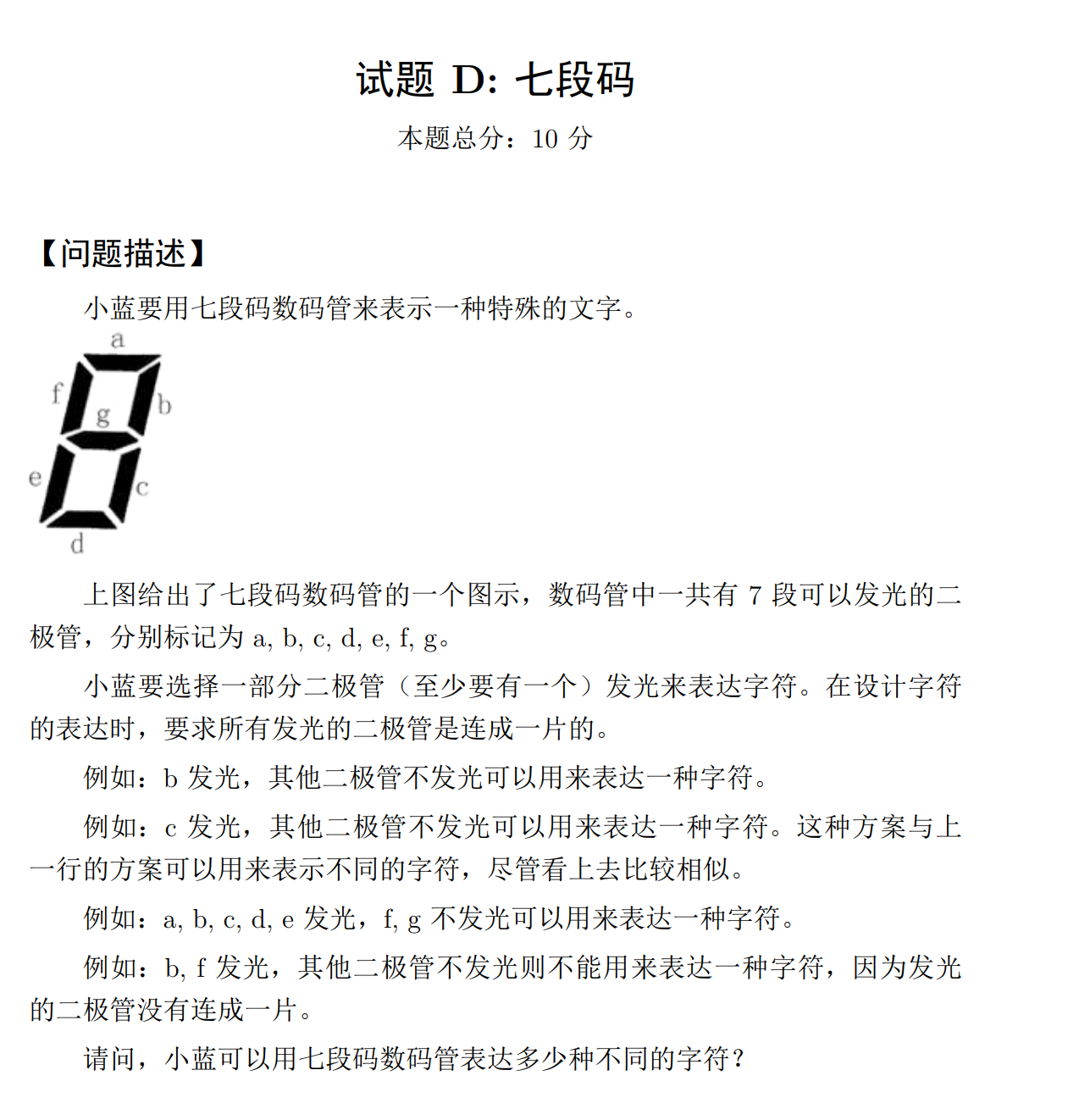Python 用推导式解决“七段码”问题

源代码
from itertools import chain,combinations as comb
if __name__ == '__main__':
L = list('abcdefg')
C = [[''.join(c) for c in list(comb(L,i+1)) if 'g' in c] for i in range(7)]
D = list(chain.from_iterable(C))
X = [e for e in D if 'a' in e and 'b' not in e and 'f' not in e
or 'd' in e and 'c' not in e and 'e' not in e]
E = [d for d in D if d not in X]
L = list('abcdef')*2
A = [L[i:j] for i in range(len(L)) for j in range(i+1,len(L)+1) if len(L[i:j])<7]
B = list(set([''.join(sorted(a)) for a in A]))
F = sorted(B + E)
print('可表达字符总数:',len(F))
print('所有组合的列表:',F)运行结果
可表达字符总数: 80
所有组合的列表: ['a', 'ab', 'abc', 'abcd', 'abcde', 'abcdef', 'abcdefg', 'abcdeg', 'abcdf', 'abcdfg', 'abcdg', 'abcef', 'abcefg', 'abceg', 'abcf', 'abcfg', 'abcg', 'abdef', 'abdefg', 'abdeg', 'abef', 'abefg', 'abeg', 'abf', 'abfg', 'abg', 'acdef', 'acdefg', 'acdfg', 'acefg', 'acfg', 'adef', 'adefg', 'aef', 'aefg', 'af', 'afg', 'b', 'bc', 'bcd', 'bcde', 'bcdef', 'bcdefg', 'bcdeg', 'bcdfg', 'bcdg', 'bcefg', 'bceg', 'bcfg', 'bcg', 'bdefg', 'bdeg', 'befg', 'beg', 'bfg', 'bg', 'c', 'cd', 'cde', 'cdef', 'cdefg', 'cdeg', 'cdfg', 'cdg', 'cefg', 'ceg', 'cfg', 'cg', 'd', 'de', 'def', 'defg', 'deg', 'e', 'ef', 'efg', 'eg', 'f', 'fg', 'g']
解题思路
分两类进行分别计算:第一类是g段处于点亮状态,即在'abcdefg'中取出所有字母组合,但要排除不包含g的,排除后有64种;最后还要排除含a但不含b或f的、含d但不含c或e的共15个(“有了a但没有b或f就形成ag不连通”,另一个同理),排除后共49种组合。
第二类是g段不点亮状态即不包含g段,可以看作a~f组成的是一个环(零),所以需要在双倍长度的字符串'abcdefabcdef'中取出所有长度为1~6的所有子串,共有57种;每个字串内部作排序后再去重,留下31种组合。这样,两类总共合计有80种组合。

import itertools
class UnionFindSet():
def __init__(self,n):
self.count = 0 # 当前连通分量数目
# self.count = n # 不连通区域
self.father=[x for x in range(n)]
def find(self,x):
root = x
while self.father[root]!=root: # 找根节点
root=self.father[root]
# 路径压缩
while x != root:
o = self.father[x] # 找x的父节点
self.father[x] = root # 把x的父节点设置成刚才找到的根
x = o # 往上一层
return root
def union(self,x,y):
x,y=self.find(x),self.find(y)
if x != y:
self.father[y]=x # 合并
self.count +=1
return 0
result = 0
nums = [x for x in range(7)]
for x in range(1,8): # 每次用的晶体管个数
for k in itertools.combinations(nums, x): #从所有的晶体管中按个数要求不重复的拿。
l = len(k)#晶体管的个数
ufs = UnionFindSet(l)
#两两的逐个选取
for a in range(l):
for b in range(a+1,l):
#根据下图的数字判断两个晶体管是否相邻。
if abs(k[a]-k[b])==1 or (k[a]==1 and k[b]==6) or (k[a]==2 and k[b]==6) or (k[a]==4 and k[b]==6) or (k[a]==0 and k[b]==5):
ufs.union(a,b)
if l-ufs.count==1: #比如当用到三个二极管的时候只需要链接两次,那么当晶体管个数减去链接次数为1的时候符合要求。
result += 1
print(result)
相关文章
- [Python] 使用print作进度条(解决end=''时print不显示的问题)
- Python怎么输入小数和整数_python输入非负整数
- 简述python变量的命名规则_Python 变量命名规则
- python不换行输出
- python基础系列教程——Python的安装与测试:python解释器、PyDev编辑器、pycharm编译器
- python chr()和ord()_Python函数ord
- python setattr函数_Python内置函数(53)——setattr
- 【说站】python中mock的断言使用
- 【说站】python面对用户无意义输入的解决
- 经纬度距离计算 python_Python已知两坐标求距离
- Python标识符的命名规则,下列哪些是对的?_python标识符不能使用关键字
- 基于卷积神经网络的手写数字识别系统_python 卷积神经网络
- python利用海伦公式求三角形的面积
- python语言关键字是_Python 关键字
- Python 生成随机数_python建立随机数列表
- python中if判断语句的用法_Python if判断语句的用法详细介绍[通俗易懂]
- python 可迭代对象 迭代器 生成器_Python3迭代器获取
- python分段线性插值_Python实现分段线性插值
- python控制谷歌浏览器_python安装插件
- lxml安装不上,经过了以下尝试:删掉python然后重新安装,更新了pip到最新版,仍不能解决
- PythonRobotics | 基于python的机器人自主导航
- aes加密算法python版本
- 软件测试|Python基础之面向对象(一)
- Python for循环及用法详解
- PostgreSQL连接python,postgresql在python 连接,创建表,创建表内容,插入操作,选择操作,更新操作,删除操作。详解数据库
- python通过代理服务器访问ftp服务详解编程语言
- SSH代理连接器的Python代码详解编程语言
- Python PEP文档:及时追踪Python最新变化
- Linux查看Python版本的有效方法(linux查看python版本)
- Python脚本实现Linux系统管理及自动化部署(python写linux)
- python驱动使用pip安装MySQL Python驱动的简单步骤(pip安装mysql)
- Python中用Ctrl+C终止多线程程序的问题解决
- python使用7z解压软件备份文件脚本分享
- python操作mysql中文显示乱码的解决方法

